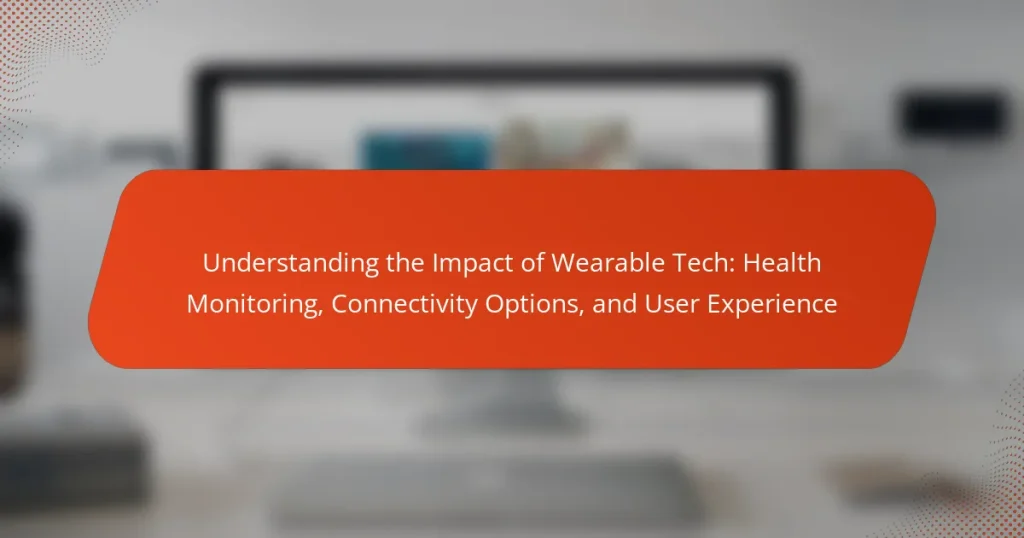Wearable technology encompasses electronic devices designed to be worn on the body, primarily for health monitoring and connectivity. These devices, including smartwatches, fitness trackers, and smart glasses, enable users to track vital health metrics such as heart rate and sleep patterns while providing communication features through smartphone integration. The global wearable technology market, valued at approximately $116 billion in 2021, reflects a growing consumer interest in enhancing personal health and wellness. This article explores the impact of wearable tech on health monitoring, connectivity options, and user experience, highlighting its significance in modern lifestyle management.

What is Wearable Tech and Its Purpose?
Wearable tech refers to electronic devices that can be worn on the body. These devices often monitor health metrics, track fitness activities, or provide connectivity options. Common examples include smartwatches, fitness trackers, and smart glasses. The primary purpose of wearable tech is to enhance personal health and wellness. It enables users to track vital signs such as heart rate and sleep patterns. Additionally, wearable tech fosters connectivity by allowing notifications and communication through paired smartphones. The global wearable technology market was valued at approximately $116 billion in 2021, indicating significant consumer interest and investment.
How does wearable tech impact health monitoring?
Wearable tech significantly enhances health monitoring by providing real-time data tracking. Devices like fitness trackers and smartwatches can monitor heart rate, sleep patterns, and physical activity. This continuous data collection allows users to gain insights into their health status. Studies show that individuals using wearable tech are more likely to engage in physical activity. For instance, a study published in the Journal of Medical Internet Research found that users increased their activity levels by 30% when using fitness wearables. Wearable tech also enables remote monitoring by healthcare providers, improving patient outcomes. This technology fosters personalized health management through data-driven insights.
What types of health metrics can wearable tech track?
Wearable tech can track various health metrics. Common metrics include heart rate, steps taken, and calories burned. Many devices also monitor sleep patterns and quality. Some wearables track blood oxygen levels and stress levels. Advanced models can measure ECG and skin temperature. Users benefit from real-time feedback on their health. Research indicates that tracking these metrics can improve overall wellness.
How accurate are the health monitoring features of wearable devices?
The health monitoring features of wearable devices are generally accurate but can vary by device and measurement type. For instance, heart rate monitoring is often accurate within 5% of clinical measurements. A study published in the Journal of Medical Internet Research found that consumer-grade wearables can accurately track steps and heart rate during exercise. However, accuracy may decrease during high-intensity activities or in individuals with certain health conditions. Blood oxygen level measurements are typically less reliable, with some devices showing discrepancies of up to 10%. Overall, while wearable devices provide useful health insights, users should be aware of their limitations.
What are the connectivity options available in wearable tech?
Wearable tech primarily utilizes Bluetooth, Wi-Fi, and cellular connectivity options. Bluetooth is commonly used for short-range communication with smartphones and other devices. It enables data transfer and notifications between wearables and paired devices. Wi-Fi allows wearables to connect to the internet directly. This facilitates data syncing and real-time updates without needing a smartphone connection. Cellular connectivity provides wearables with independent internet access. This is particularly useful for GPS tracking and communication on the go. Each connectivity option enhances the functionality and user experience of wearable devices.
How do different connectivity options enhance user experience?
Different connectivity options enhance user experience by providing seamless access to data and services. Bluetooth connectivity allows for quick pairing with devices, enabling real-time health monitoring. Wi-Fi connectivity offers faster data transfer rates, improving the efficiency of updates and syncing. Cellular connectivity enables users to access features without relying on other devices, increasing mobility.
These options also support a wider range of applications, enhancing functionality. For instance, devices with GPS connectivity can offer location-based services, improving navigation and fitness tracking. Additionally, multiple connectivity options ensure redundancy, maintaining user experience even if one connection fails.
Research shows that 70% of users prefer devices with versatile connectivity options, as it allows for greater flexibility and convenience in daily use. This adaptability ultimately leads to higher user satisfaction and engagement with wearable technology.
What are the advantages and disadvantages of various connectivity methods?
Various connectivity methods have distinct advantages and disadvantages. Bluetooth is widely used for its low energy consumption and ease of pairing. However, its range is limited, typically around 30 feet. Wi-Fi offers higher data transfer speeds and broader coverage. Its downside includes higher power consumption and potential network congestion. Cellular connectivity provides extensive coverage and mobility. Yet, it often incurs additional costs and may suffer from latency issues. NFC enables quick and secure transactions but has a very short range, limiting its use. Zigbee is energy-efficient and suitable for smart devices, but it lacks the data speed of Wi-Fi. Each method has trade-offs depending on the specific use case in wearable technology.
What role does user experience play in wearable tech?
User experience is crucial in wearable tech as it directly influences user satisfaction and product adoption. A positive user experience enhances usability, making devices intuitive and easy to navigate. Wearable tech must provide clear feedback and seamless interaction to engage users effectively. Research shows that 70% of users abandon devices due to poor usability. Additionally, effective user experience design can improve health outcomes by encouraging consistent use of health monitoring features. Thus, user experience significantly impacts the success and functionality of wearable technology.
How does user interface design affect the usability of wearable devices?
User interface design significantly affects the usability of wearable devices. A well-designed interface enhances user interaction and efficiency. It influences how easily users can navigate features and access information. Intuitive layouts reduce learning curves and improve user satisfaction. Research shows that 70% of users prefer devices with simple, clear interfaces. Complex designs can lead to frustration and decreased engagement. Effective interface design prioritizes essential functions and minimizes distractions. This approach ensures that users can quickly access health monitoring features. Ultimately, user interface design is crucial for maximizing the potential of wearable technology.
What factors contribute to overall user satisfaction with wearable tech?
User satisfaction with wearable tech is influenced by several key factors. These include device functionality, design, battery life, and user interface. Functionality encompasses the range of features, such as health monitoring and connectivity options. A well-designed device enhances comfort and aesthetics, which are crucial for daily wear. Battery life is essential for continuous use without frequent charging. An intuitive user interface facilitates ease of use, contributing to a positive experience. According to a study by Statista, 80% of users prioritize functionality and design when selecting wearable tech.
How do health monitoring features integrate with connectivity options?
Health monitoring features integrate with connectivity options through data transmission and synchronization. Wearable devices collect health metrics like heart rate and activity levels. These devices use Bluetooth or Wi-Fi to send data to smartphones or cloud services. This connectivity allows users to access real-time health insights. Additionally, integration with apps enhances user engagement and data visualization. The seamless exchange of information supports remote health management. According to a 2021 study published in the Journal of Medical Internet Research, 70% of users report improved health awareness through connected devices.
What are the emerging trends in wearable tech user experience?
Emerging trends in wearable tech user experience include enhanced personalization, improved health tracking, and seamless connectivity. Personalization allows users to tailor devices to their specific needs and preferences. This trend is supported by advancements in AI and machine learning, which analyze user behavior. Improved health tracking features now offer real-time data and insights, making health management more proactive. Integration with telehealth services is also on the rise, providing users with direct access to healthcare professionals. Seamless connectivity across devices enhances user experience by allowing for easy data sharing and interaction. The proliferation of 5G technology further supports these connectivity improvements, enabling faster and more reliable communication. Enhanced battery life and design are also key trends, ensuring devices are more user-friendly and accessible.
What best practices can enhance the effectiveness of wearable tech?
To enhance the effectiveness of wearable tech, users should prioritize regular updates and maintenance. Keeping software current ensures optimal performance and security. Users should also select devices that offer personalized features tailored to their specific health needs. This customization can lead to better user engagement and satisfaction. Additionally, integrating wearable tech with other health applications can provide a comprehensive view of health data. Studies show that users who track their data consistently see improved health outcomes. Regular syncing with smartphones or other devices enhances data accuracy. Lastly, participating in community forums can provide valuable insights and tips for maximizing device utility.
How can users maximize the benefits of health monitoring features?
Users can maximize the benefits of health monitoring features by consistently tracking their health metrics. Regularly reviewing data helps identify trends and patterns. Users should set specific health goals based on their monitored metrics. This targeted approach encourages accountability and motivation. Engaging with the app’s community features can provide support and encouragement. Users should also ensure their devices are updated for optimal performance. Utilizing reminders for medication or activity can enhance adherence to health plans. Integrating health data with healthcare providers improves personalized care. Studies show that consistent monitoring leads to better health outcomes, such as a 30% improvement in chronic disease management.
What troubleshooting tips are essential for wearable tech users?
Essential troubleshooting tips for wearable tech users include checking battery levels regularly. Low battery can lead to device malfunctions. Users should also ensure that the device is properly synced with their smartphone. Syncing issues can disrupt functionality. Restarting the device can resolve many temporary glitches. Additionally, users should keep the device’s software updated. Software updates often include bug fixes and performance improvements. If connectivity issues arise, users should check Bluetooth settings on their smartphone. This can help restore connections. Finally, consulting the user manual can provide specific troubleshooting steps for unique problems.
Wearable tech encompasses electronic devices designed to be worn on the body, primarily for health monitoring and connectivity purposes. This article explores the impact of wearable technology on health metrics tracking, including heart rate and sleep patterns, as well as the various connectivity options such as Bluetooth and Wi-Fi that enhance user experience. It also examines the accuracy of health monitoring features, the importance of user interface design, and emerging trends in wearable tech. Key factors influencing user satisfaction and best practices for maximizing the benefits of these devices are also discussed, providing a comprehensive overview of the wearable tech landscape.




